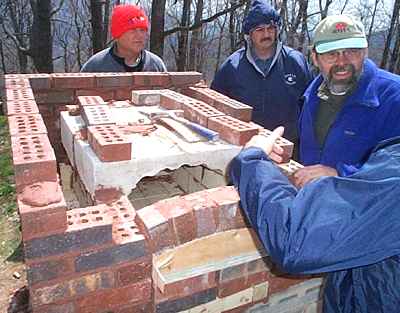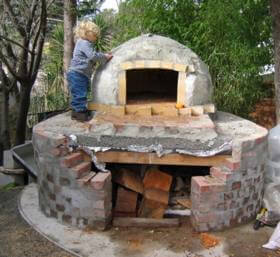Ok, I'm gonna say something that may be completely wrong, but I'd like some feedback from people who have practical experience. In my field (clockmaking) there's nothing more irritating than some amateur, who has no experience or feel for the traditions of the craft, get on some list and say that something that has been done for hundreds of years is completely wrong. So here goes.
I think that for the purposes of a home oven that the pompeii oven is too thick, or has too much thermal mass. For my purposes, I want an oven that will heat up quickly and efficiently to make some pizza, and retain enough heat to bake one batch of bread, or at a stretch, bake the Thanksgiving turkey.
For my purposes, I don't think the oven needs to be much thicker than the commercialy made refractory pizza ovens. It seems to me that that with three simple changes, I'd get an oven that's much more fuel efficient, and is ready to bake more quickly:
1) Lay the oven floor with the fire clay slurry directly on the insulating layer of the hearth, without that addtitonal slug of concrete for thermal mass.
2) Make the first, or soldier course, of the oven with wide side of the half bricks facing in, instead of the narrow side.
3) Build the dome with fire bricks cut in thirds rather than half, reducing the thickness of the dome from 4-and-change to two-and-a-half.
Now I know that cutting the fire bricks in thirds will leave some bricks without a factory edge, and a cut face looks different than a factory face, but I could use these middle sections on either side of the opening where they are less visible. It also means that each brick needs full cuts rather than score-and-break treatment, but I'm inclined to get the big brick saw anyway.
I don't mean this to be critical of the people who have designed and built the pompeii oven. I know the project was designed to built by beginners in masonry, who could split the bricks with an inexpensive brick set. I just think that these few changes could make it a better home oven.
Any comments?
I think that for the purposes of a home oven that the pompeii oven is too thick, or has too much thermal mass. For my purposes, I want an oven that will heat up quickly and efficiently to make some pizza, and retain enough heat to bake one batch of bread, or at a stretch, bake the Thanksgiving turkey.
For my purposes, I don't think the oven needs to be much thicker than the commercialy made refractory pizza ovens. It seems to me that that with three simple changes, I'd get an oven that's much more fuel efficient, and is ready to bake more quickly:
1) Lay the oven floor with the fire clay slurry directly on the insulating layer of the hearth, without that addtitonal slug of concrete for thermal mass.
2) Make the first, or soldier course, of the oven with wide side of the half bricks facing in, instead of the narrow side.
3) Build the dome with fire bricks cut in thirds rather than half, reducing the thickness of the dome from 4-and-change to two-and-a-half.
Now I know that cutting the fire bricks in thirds will leave some bricks without a factory edge, and a cut face looks different than a factory face, but I could use these middle sections on either side of the opening where they are less visible. It also means that each brick needs full cuts rather than score-and-break treatment, but I'm inclined to get the big brick saw anyway.
I don't mean this to be critical of the people who have designed and built the pompeii oven. I know the project was designed to built by beginners in masonry, who could split the bricks with an inexpensive brick set. I just think that these few changes could make it a better home oven.
Any comments?








 ) reasoning.
) reasoning. i would be surprised if tweaking this a little one way or another will result in dramatic differences.
i would be surprised if tweaking this a little one way or another will result in dramatic differences.

Comment